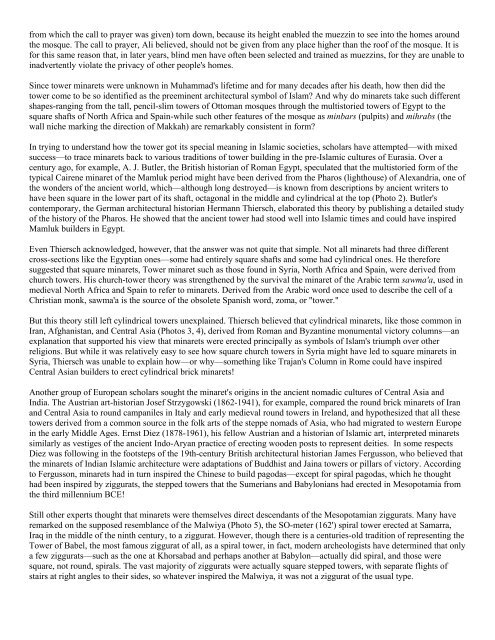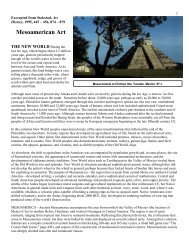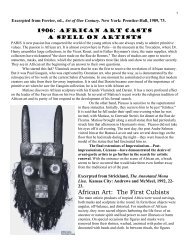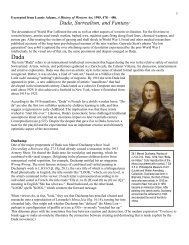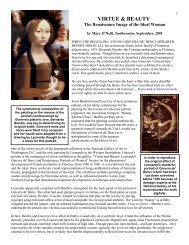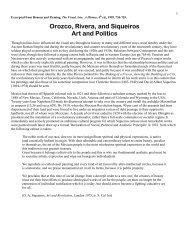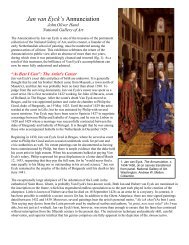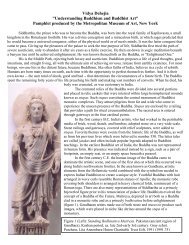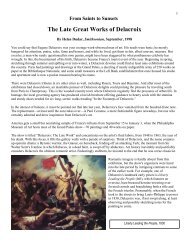The Minaret, Symbol of Power and Faith, Aramco World, MarAp.pdf
The Minaret, Symbol of Power and Faith, Aramco World, MarAp.pdf
The Minaret, Symbol of Power and Faith, Aramco World, MarAp.pdf
Create successful ePaper yourself
Turn your PDF publications into a flip-book with our unique Google optimized e-Paper software.
from which the call to prayer was given) torn down, because its height enabled the muezzin to see into the homes aroundthe mosque. <strong>The</strong> call to prayer, Ali believed, should not be given from any place higher than the ro<strong>of</strong> <strong>of</strong> the mosque. It isfor this same reason that, in later years, blind men have <strong>of</strong>ten been selected <strong>and</strong> trained as muezzins, for they are unable toinadvertently violate the privacy <strong>of</strong> other people's homes.Since tower minarets were unknown in Muhammad's lifetime <strong>and</strong> for many decades after his death, how then did thetower come to be so identified as the preeminent architectural symbol <strong>of</strong> Islam? And why do minarets take such differentshapes-ranging from the tall, pencil-slim towers <strong>of</strong> Ottoman mosques through the multistoried towers <strong>of</strong> Egypt to thesquare shafts <strong>of</strong> North Africa <strong>and</strong> Spain-while such other features <strong>of</strong> the mosque as minbars (pulpits) <strong>and</strong> mihrabs (thewall niche marking the direction <strong>of</strong> Makkah) are remarkably consistent in form?In trying to underst<strong>and</strong> how the tower got its special meaning in Islamic societies, scholars have attempted—with mixedsuccess—to trace minarets back to various traditions <strong>of</strong> tower building in the pre-Islamic cultures <strong>of</strong> Eurasia. Over acentury ago, for example, A. J. Butler, the British historian <strong>of</strong> Roman Egypt, speculated that the multistoried form <strong>of</strong> thetypical Cairene minaret <strong>of</strong> the Mamluk period might have been derived from the Pharos (lighthouse) <strong>of</strong> Alex<strong>and</strong>ria, one <strong>of</strong>the wonders <strong>of</strong> the ancient world, which—although long destroyed—is known from descriptions by ancient writers tohave been square in the lower part <strong>of</strong> its shaft, octagonal in the middle <strong>and</strong> cylindrical at the top (Photo 2). Butler'scontemporary, the German architectural historian Hermann Thiersch, elaborated this theory by publishing a detailed study<strong>of</strong> the history <strong>of</strong> the Pharos. He showed that the ancient tower had stood well into Islamic times <strong>and</strong> could have inspiredMamluk builders in Egypt.Even Thiersch acknowledged, however, that the answer was not quite that simple. Not all minarets had three differentcross-sections like the Egyptian ones—some had entirely square shafts <strong>and</strong> some had cylindrical ones. He thereforesuggested that square minarets, Tower minaret such as those found in Syria, North Africa <strong>and</strong> Spain, were derived fromchurch towers. His church-tower theory was strengthened by the survival the minaret <strong>of</strong> the Arabic term sawma'a, used inmedieval North Africa <strong>and</strong> Spain to refer to minarets. Derived from the Arabic word once used to describe the cell <strong>of</strong> aChristian monk, sawma'a is the source <strong>of</strong> the obsolete Spanish word, zoma, or "tower."But this theory still left cylindrical towers unexplained. Thiersch believed that cylindrical minarets, like those common inIran, Afghanistan, <strong>and</strong> Central Asia (Photos 3, 4), derived from Roman <strong>and</strong> Byzantine monumental victory columns—anexplanation that supported his view that minarets were erected principally as symbols <strong>of</strong> Islam's triumph over otherreligions. But while it was relatively easy to see how square church towers in Syria might have led to square minarets inSyria, Thiersch was unable to explain how—or why—something like Trajan's Column in Rome could have inspiredCentral Asian builders to erect cylindrical brick minarets!Another group <strong>of</strong> European scholars sought the minaret's origins in the ancient nomadic cultures <strong>of</strong> Central Asia <strong>and</strong>India. <strong>The</strong> Austrian art-historian Josef Strzygowski (1862-1941), for example, compared the round brick minarets <strong>of</strong> Iran<strong>and</strong> Central Asia to round campaniles in Italy <strong>and</strong> early medieval round towers in Irel<strong>and</strong>, <strong>and</strong> hypothesized that all thesetowers derived from a common source in the folk arts <strong>of</strong> the steppe nomads <strong>of</strong> Asia, who had migrated to western Europein the early Middle Ages. Ernst Diez (1878-1961), his fellow Austrian <strong>and</strong> a historian <strong>of</strong> Islamic art, interpreted minaretssimilarly as vestiges <strong>of</strong> the ancient Indo-Aryan practice <strong>of</strong> erecting wooden posts to represent deities. In some respectsDiez was following in the footsteps <strong>of</strong> the 19th-century British architectural historian James Fergusson, who believed thatthe minarets <strong>of</strong> Indian Islamic architecture were adaptations <strong>of</strong> Buddhist <strong>and</strong> Jaina towers or pillars <strong>of</strong> victory. Accordingto Fergusson, minarets had in turn inspired the Chinese to build pagodas—except for spiral pagodas, which he thoughthad been inspired by ziggurats, the stepped towers that the Sumerians <strong>and</strong> Babylonians had erected in Mesopotamia fromthe third millennium BCE!Still other experts thought that minarets were themselves direct descendants <strong>of</strong> the Mesopotamian ziggurats. Many haveremarked on the supposed resemblance <strong>of</strong> the Malwiya (Photo 5), the SO-meter (162') spiral tower erected at Samarra,Iraq in the middle <strong>of</strong> the ninth century, to a ziggurat. However, though there is a centuries-old tradition <strong>of</strong> representing theTower <strong>of</strong> Babel, the most famous ziggurat <strong>of</strong> all, as a spiral tower, in fact, modern archeologists have determined that onlya few ziggurats—such as the one at Khorsabad <strong>and</strong> perhaps another at Babylon—actually did spiral, <strong>and</strong> those weresquare, not round, spirals. <strong>The</strong> vast majority <strong>of</strong> ziggurats were actually square stepped towers, with separate flights <strong>of</strong>stairs at right angles to their sides, so whatever inspired the Malwiya, it was not a ziggurat <strong>of</strong> the usual type.


